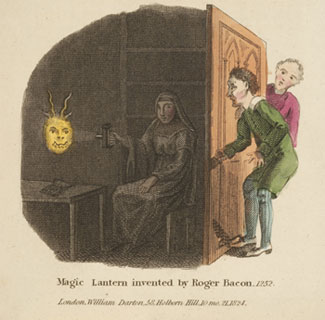

3. Chronology, from the creation of
the world to the year 1825.
London: William Darton, ca. 1825.
The great Dutch astronomer and mathematician Christiaan Huygens (1629-1695) is supposed to have devised the earliest known magic lantern in 1659 for his children's amusement. In England, however, its invention was often attributed to Roger Bacon (1214?-1294?), the English Franciscan monk who was an early proponent of experimental science and author of a treatise on optics. In the popular imagination Roger Bacon loomed large as a sorcerer, who was supposed to have created a talking head of brass. It was also believed that he had burned down a town's statehouse using nothing more than mirrors to show off his powers to a king.
This hand-colored engraved book illustration shows Bacon with a hand-held
lantern in the middle of a rather theatrical demonstration of the principles
of optics. The unsuspecting Oxford undergraduate is clearly frightened
by the image he sees projected on the wall of the darkened room. Images
like these suggest that the scientist could sometimes be confused with
the showman in the early modern period.
